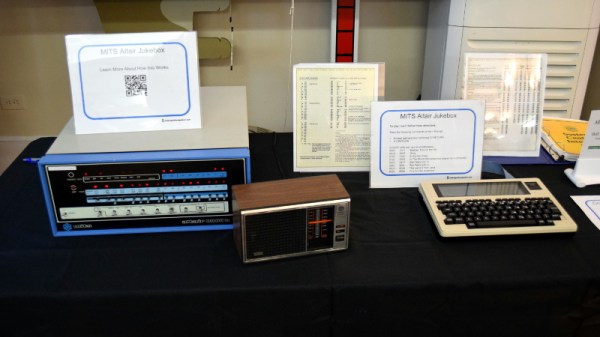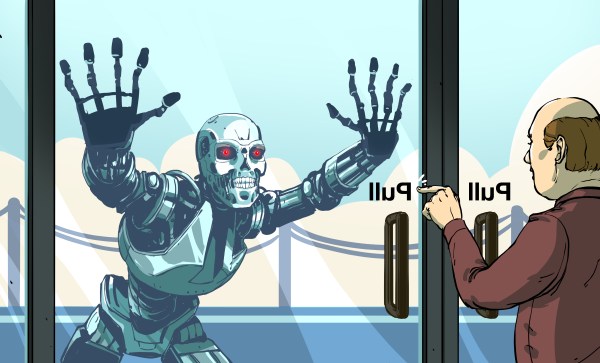You’d be forgiven if you thought software defined radio (SDR) was a relatively recent discovery. After all, few outside of the hardcore amateur radio circles were even familiar with the concept until it was discovered that cheap USB TV tuners could be used as fairly decent receivers from a few hundred MHz all the way up into the GHz range. The advent of the RTL-SDR project in 2012 brought the cost of entry level SDR hardware from hundreds of dollars to tens of dollars effectively overnight. Today there’s more hackers cruising the airwaves via software trickery than there’s ever been before.
bill gates5 Articles
Doing It With Fewer Bytes Than Bill Gates
The MITS Altair 8800 occupies a unique place in computing history as the first commercially succesful microcomputer for personal rather than business use. It is famous as the platform upon which the first Microsoft product ran, their first BASIC interpreter.
[Josh Bensadon] has an Altair 8800, and became intrigued by its bootloader. The simplest method of programming the machine is through binary using a set of switches on the front panel, and he remarks that there should be a warning in the manual: “fingers will get sore after repeated use of the small switches on the ALTAIR”.
In the Altair manual there are two listings, one 21 byte, and another in 20 bytes. Bill Gates is on record as saying that their first effort was 46 bytes long, but with more work he managed to create one in 17 bytes. Now [Josh] has beaten that, he’s created an Altair 8800 bootloader in only 14 bytes.
His write-up goes into great detail about how those bytes are shaved off, and provides us with a fascinating insight into the 8800’s architecture. Even if your 8-bit assembler is a little rusty, it’s a fascinating read.
We’ve featured Altair-inspired projects many times here at Hackaday, but rarely the real thing. This Altair PC case with the ability to emulate the original was rather a nice idea, as was this Altair front panel project. If you want the joy without the heartache though, there is an online emulator.
Kids! Don’t Try This At Home! Robot Destroys Mankind
From the Forbin Project, to HAL 9000, to War Games, movies are replete with smart computers that decide to put humans in their place. If you study literature, you’ll find that science fiction isn’t usually about the future, it is about the present disguised as the future, and smart computers usually represent something like robots taking your job, or nuclear weapons destroying your town.
Lately, I’ve been seeing something disturbing, though. [Elon Musk], [Bill Gates], [Steve Wozniak], and [Stephen Hawking] have all gone on record warning us that artificial intelligence is dangerous. I’ll grant you, all of those people must be smarter than I am. I’ll even stipulate that my knowledge of AI techniques is a little behind the times. But, what? Unless I’ve been asleep at the keyboard for too long, we are nowhere near having the kind of AI that any reasonable person would worry about being actually dangerous in the ways they are imagining.
Smart Guys Posturing
Keep in mind, I’m interpreting their comments as saying (essentially): “Soon machines will think and then they will out-think us and be impossible to control.” It is easy to imagine something like a complex AI making a bad decision while driving a car or an airplane, sure. But the computer that parallel parks your car isn’t going to suddenly take over your neighborhood and put brain implants in your dogs and cats. Anyone who thinks that is simply not thinking about how these things work. The current state of computer programming makes that as likely as saying, “Perhaps my car will start flying and we can go to Paris.” Ain’t happening.
Continue reading “Kids! Don’t Try This At Home! Robot Destroys Mankind”
A Digital Condom A Reality Thanks To Arduino
[Bill Gates]’ foundation is currently offering up a ton of prizes for anyone who can improve the condom. It’s a laudable goal, and somewhat difficult; one of the main reasons why male condoms aren’t used as often as they should is the, “male perspective… that condoms decrease pleasure as compared to no condom.”
While most of the work inspired by the [Gates] foundation is work investigating a change in the geometry of the condom, [Firaz Peer] and [Andrew Quitmeyer] of Georgia Tech managed to solve this problem with an Arduino.
The basic idea of the Electric Eel – yes, that’s the name – is to deliver short electric impulses, “along the underside of the shaft for increased stimulation”. These impulses are delivered in response to different sensor inputs – in the video example (surprisingly safe for work) they’re using a force resistor wrapped around the chest for an electrical stimulation with every breath.
Although this is only a prototype, the hope is the conductors in the condom can eventually be implanted along the inside surface of a condom during manufacturing.
Video after the break.
Continue reading “A Digital Condom A Reality Thanks To Arduino”
Humanizing Microsoft

Ok, you’ve probably already seen it. If not, go watch the new Microsoft commercial right now. The commercial itself is nothing amazing. Its an obvious attempt to humanize [Bill Gates] and Microsoft. [Bill] is almost endearing in his clunky delivery of the lines. We could even get to like him. Imagine him stumbling through the world as a normal guy dealing with software as the rest of us do. Would he change things? Could we get a sitcom with [Bill Gates] and [John Hodgman]? Would you watch it? We would.















